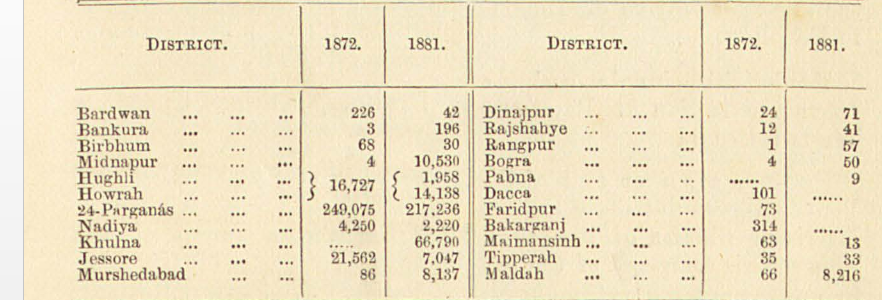Pod
Contents |
Pod
This section has been extracted from THE TRIBES and CASTES of BENGAL. Ethnographic Glossary. Printed at the Bengal Secretariat Press. 1891. . |
NOTE 1: Indpaedia neither agrees nor disagrees with the contents of this article. Readers who wish to add fresh information can create a Part II of this article. The general rule is that if we have nothing nice to say about communities other than our own it is best to say nothing at all.
NOTE 2: While reading please keep in mind that all posts in this series have been scanned from a very old book. Therefore, footnotes have got inserted into the main text of the article, interrupting the flow. Readers who spot scanning errors are requested to report the correct spelling to the Facebook page, Indpaedia.com. All information used will be gratefully acknowledged in your name.
This section has been extracted from THE TRIBES and CASTES of BENGAL. Ethnographic Glossary. Printed at the Bengal Secretariat Press. 1891. . |
NOTE 1: Indpaedia neither agrees nor disagrees with the contents of this article. Readers who wish to add fresh information can create a Part II of this article. The general rule is that if we have nothing nice to say about communities other than our own it is best to say nothing at all.
NOTE 2: While reading please keep in mind that all posts in this series have been scanned from a very old book. Therefore, footnotes have got inserted into the main text of the article, interrupting the flow. Readers who spot scanning errors are requested to report the correct spelling to the Facebook page, Indpaedia.com. All information used will be gratefully acknowledged in your name.
Origin
Padmaraji, Chasi, a fishing, cultivating, landholding, and trading caste of Lower Bengal, found in large numbers io the 24-Parganas. Their origin is uncertain. Babu Bankim Chandra Chatterji, quoted at page 188 of the Census Report of 1872, notices their" marked approach to the Turanian and aboriginal type" of features, and seeks to identify them with the Pundra mentioned in the MaMbMrata as one of the five chief races of Eastern India between Magadha and the sea. The educated members of the caste claim for it a mixed descent from a Kayasth father and a NApit mother. Others tell a highly indeli¬cate story regarding the miraculous birth of the first Pod from Revati, the wife of Balaram.
Internal structure
The Pods are divided into four sub-castes-Bagande, Bangia, Khotta, or Mauna and Uraiya. The first two are found chiefly in the 24-Parganas and Jessore, the third in Murshedabad and Maldah, and the fourth in Midnapur and Balasore. All these groups are endogamous. Each is subdivided into gotras or sections borrowed from the Brabmaoioal system. The prohibited degrees are the same as among the higher castes.
Marriage
Pods marry their daughters between the ages of five and nine years, forbid widow-marriage, and do not recognize divorce. The morality of Pod widows, however, is alleged to be singularly lax, and the caste is tolerant towards sexual indiscretions, so that the illegitimate children of widows and of divorced women are received into the community. Their marriage i of the orthodox type, the ceremony of Ku.sandika alone being omitted. Sampradan, or the offering of the bride to the bridegroom and his acceptance of the gift, forms the binding portion of the ritual.
Religion
In addition to the well-known sects of Saiva, Sakta, and . . Vaishnava, we find among the Pods a large number of Sauras and Ganapatyas, sects very sparingly represented among the higher classes of Hindus in Bengal. The caste employ as their priests Harhi Brahmans, who are held to be so far degraded by serving them that high class Brahmans will not take food or water from their hands. The gurus of the Pods are Harhi Gosa-ins, but these, I understand, have in no way forfeited their position among Brahmans, though in some cases they eat and drink in Pods' houses. An instance of this was brought to my notice recently as evidence of the growth of the spirit of religious toleration among the educated Hindus of Calcutta and its suburbs.
Social status
The social status of Pods is decidedly low. They will eat sweetmeats, drink and smoke with the fishing sub-castes of Bagdis; and these are ordinarily deemed to be nearly their equals in rank. Brahmans and members of the Nava SAkha group will not take water from them; and the Sutradhar and Kapali, while they will eat sweetmeats, drink and smoke in company with a Pod, will not use the same pipe or drink from the same lutd. In matters of diet their practice is orthodox on all points except the indulgence in strong drink. They will eat the leavings of Brahmans. Vaishnava Pods abstain from all kinds of flesh.
Occupation
The great majority of the caste are engaged in agriculture, as tenure• holders, aud occupancy or non-occupancy raiyats. A few have risen to be zamindar , and some at the other end of the scale work as nomadic cultivators on freshly-cleared land in the Sundar bans, changing their location every two or three years according to the fortune of their crops. Many Pods have taken to trade, and gold¬smiths, blacksmiths, tinsmiths, carpenters, thatchers, etc., are found among them. The following statement shows the number and distribution of Pods in Bengal in 1872 nnd 1881 :¬
